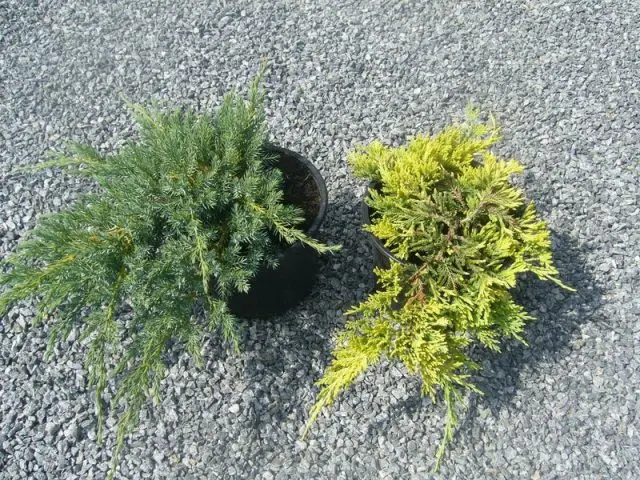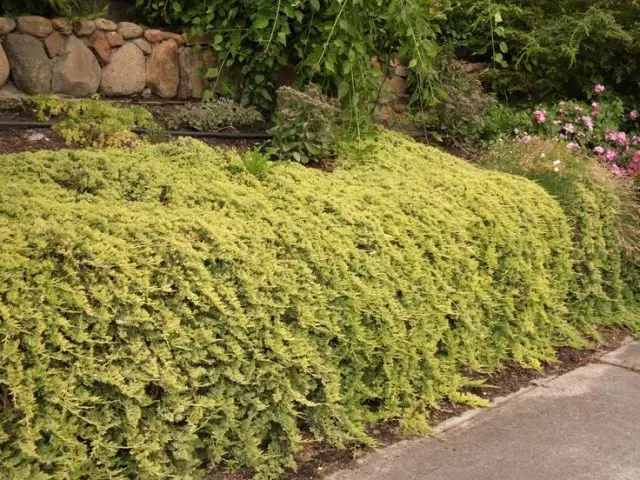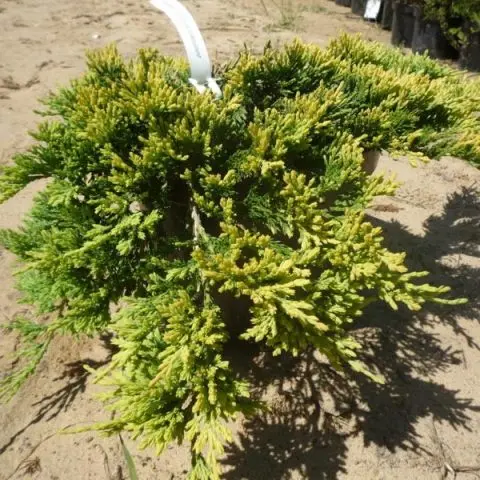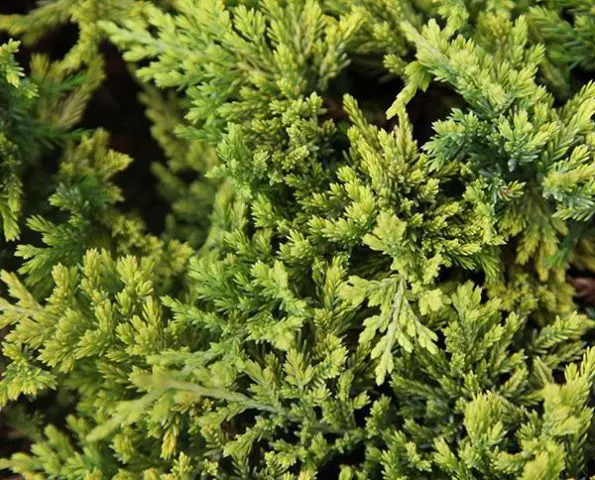Contents
Coniferous cultures are distinguished by unique decorative features. This is a win-win option for decorating the site. Juniper Golden Carpet – one of the varieties of creeping horizontal juniper. The culture has its own characteristics of planting, requirements for care and pest control.

Description juniper Golden Carpet
The description of the horizontal juniper Golden Carpet indicates that it is a creeping variety 10–15 cm high and up to one and a half meters in diameter. The shoots are long, elastic, strong, with the ability to take root. Translated from English, the name of the variety sounds like “golden clover”.
This variety grows slowly at 10 cm per year. It has small scaly needles of golden color. The top color of the needles is golden yellow, and the bottom is yellow-green.
Fruits occasionally appear on this plant – whitish-blue cones of small size.
Juniper Golden Carpet belongs to frost-resistant plants, but loves sunny places for planting.
This variety is found in the wild throughout the Northern Hemisphere, as well as in mountainous areas.
Juniper horizontal Golden Carpet in design
Thanks to its pleasant appearance and unpretentiousness in care, Golden Carpet is used in design everywhere. It can be seen near schools, hospitals, not to mention decorating private areas.
Juniper Golden Carpet is used as a groundcover. A regular guest of the lower tier of rock gardens, flower beds, rockeries. Design professionals use the creeping variety of juniper to decorate rocky gardens and juniper lawns. Another plus for juniper in design is its unusual color, which practically does not change throughout the year.
Planting and caring for juniper horizontal Golden Carpet
To maintain the appearance of a horizontal juniper, you should take care of the plant from the moment of planting. The Golden Carpet variety is not considered capricious, but there are still some nuances in care. They must be taken into account so that the creeping juniper becomes a real decoration of the site. A feature of the juniper Golden Carpet is its unpretentiousness to the soil. You can plant in almost any area, so the plant is used to decorate rocky gardens.
Seedling and planting preparation
After a sunny place is chosen, you can begin to prepare the soil and deepen for planting juniper. The optimal soils, despite their unpretentiousness, will still be loams with a neutral level of acidity.

The depth of the hole should be 70 cm, the diameter should be 2-3 times larger than the root system of the seedling along with the earthen clod. The recipe for the optimal substrate: mix well two parts of peat, part of river sand and part of soddy soil.
Drainage should be laid at the bottom of the hole. For this, broken bricks, gravel and crushed stone are used. It is better to make a drainage layer of 20 cm. If the groundwater does not lie close, then the drainage layer can be made smaller.
If you plan to plant several juniper seedlings, then you need to make a distance of 1–2 meters between them, taking into account the size of the future decoration.
Rules of landing
When planting, it should be noted that Golden Carpet juniper has a very fragile root system. Therefore, it is recommended to plant it in a lump of old earth, so as not to damage the roots.
When planting, it is necessary to carefully straighten the existing roots, put them in a hole and sprinkle with a substrate. It is important that the root neck is not deepened. The soil around the seedling must be compacted and watered.
After planting, the shrub should be abundantly moistened during the first week.
Watering and top dressing
Juniper Golden Carpet does not like moisture at the roots, but it does not tolerate dry air either. Therefore, the optimal irrigation regime for this shrub is rain. Especially on dry, hot days. In this case, be sure to ensure that the root system is not subjected to waterlogging.
Mature plants in a normal summer with sufficient rainfall may not need to be watered frequently. Enough 2-3 watering per season. Up to three buckets of water are poured under each bush.
Juniper does not need frequent feeding. Young seedlings are fertilized in April-May. For top dressing, you should take 40 grams of nitroammophoska or any complex mineral fertilizer and apply it to the trunk circle. Then be sure to water the shrub.
Mulching and loosening
The root system of the shrub is tender. Loosening is necessary to create air access to the roots, but this should be done carefully and shallowly. Care must be taken when loosening young plants.

Mulching seedlings is necessary immediately after planting. The mulch will help retain moisture and nutrients. Proper warming of the root system will make it easy to survive the frost. Peat, sawdust, and spruce branches are used as mulch.
Mulch can perform other functions:
- Protects roots from overheating during particularly dry periods.
- Maintains acidity.
- Prevents weathering and washing out of nutrients.
- Suppresses the growth of weeds.
Mulching with peat is considered the most effective.
Trimming and shaping
The most important thing in landscape design is to properly shape the juniper. Variety Golden Carpet perfectly tolerates pruning, both sanitary and shaping. Sanitary pruning affects health, and shaping gives the necessary shape according to the designer’s ideas.
Sanitary pruning is carried out in the spring, before the start of sap flow. At this time, dry, rotten shoots are removed. All shoots damaged by diseases and cold are also cut off.
Formative pruning does not need to be done annually as the Golden Carpet grows slowly. Shrub formation is carried out in July. You should pick up sharp tools, as well as put gloves on your hands to avoid getting essential oils on your skin.
Preparation for winter
Despite the fact that Golden Carpet juniper is frost-resistant, minimal preparation for winter is still necessary. First of all, you should cover the root area with spruce branches. Can be replaced with a layer of peat. In any case, mulching will not hurt. Extra shoots, broken and weakened branches must be cut off.
Reproduction of juniper horizontal Golden Carpet
Horizontal juniper (juniperus horizontalis golden carpet) can reproduce in many ways. Each gardener chooses the most suitable method:
- Seeds. This is the most economical option, but at the same time the most time-consuming. To do this, dark blue cones of berries are harvested in the fall, from which seeds are pulled out. Seeds should be planted in a box with soil. The depth of sowing seeds is 2 cm. The box with the earth is taken out into the yard until spring. Seeds are planted in the garden in spring. It is necessary to protect the seeds from frost by mulching. This procedure will protect the seeds from weeds. A culture can be planted in a permanent place after 3 years.
- Cuttings. The most versatile method for propagating juniper Golden Carpet. Harvesting of planting material is carried out in cloudy weather. Cuttings should be cut in August, when they are already woody. These should be the tops of the shoots. After cutting, they are freed from needles and branches. Juniper shoots are pre-soaked (for an hour) in water, then immediately planted in the substrate. This should be done at an angle of 30 ° C. Don’t forget about drainage. Before planting in a permanent place, boxes with cuttings should be placed in a greenhouse with a temperature of 16–19 ° C. After the buds open, the temperature should be 26 ° C.
- Layers. Refers to popular breeding methods for creeping varieties of juniper. The action algorithm is simple:
- loosen the ground around the bush;
- add peat and water;
- clean the branches that are intended for rooting;
- retreat from the root about 20 cm;
- deepen the escape into the ground and dig;
- water and soak.
Within a year, layering will take root. They need to be separated and transplanted.

Diseases and pests
Juniper Golden Carpet on the bole is considered disease resistant, but there are some diseases that you should pay attention to:
- Fusarium wilt. A fungal disease that causes root rot. Dried plants with roots are destroyed.
- Rust.
- Drying of branches.
- Nectriosis of the bark of branches.
There are also pests from which garden plants should be regularly treated:
- juniper aphid;
- mealybug;
- juniper moth;
- common gall midge.
For prevention, it is better to use proven insecticides, presented in a wide range: Confidor, Aktara, Mospilan, Engio, Calypso, Aktelik.
Conclusion
Juniper Golden Carpet belongs to creeping varieties. It is successfully used in various types of landscape design. The culture has a pleasant appearance, as well as resistance to frost and drought. Not capricious to the choice of soil, does not require constant feeding. Juniper Golden Carpet (shown in the photo) is used as a decoration not only for garden plots, but also for gardens, parks, urban areas. The plant is long-lived and can last up to a thousand years.









